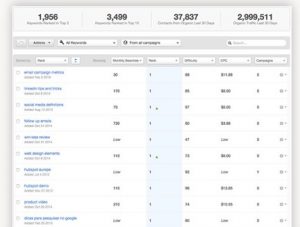Is it better to focus on finding new users or keeping returning visitors? Monetate answers: Why choose? Monetate is right on the money. Customer retention is just as important as acquisition in the ecommerce space—if not more. It’s widely known that returning visitors are usually the more revenue-generating of the two segments. From the latest Monetate Ecommerce Quarterly report:
In Q4, despite making up less than half of all ecommerce sessions (48%), returning visitors spent nearly $ 5.3 billion online— almost twice as much money as new visitors spent during the same timeframe ($ 2.7 billion).
That’s a pretty compelling statistic.
So it makes sense to focus your strategy (and advertising dollars) on converting and retaining returning users, right? Well, maybe. It’s important to remember that those returning visitors were once shiny and new, too. What’s the first step toward generating a qualified audience of loyal returning visitors? Make an impact on them when they’re new to you. Your new visitors should be greeted with an inspiring, motivating, and, most of all, memorable experience.
How can you pull that off?
Demonstrate the value propositions you offer clearly. Introduce new visitors to your one-of-a-kind product set and unparalleled customer service support, and then suggest that they stay in touch by registering for your newsletter.
Once you’ve made an impact on your new visitors, you need to keep them interested by serving them email content relevant to the experience they had on your site the first time. A visitor who returns to your site for a second or third time is a user who is primed to receive your marketing message and engage with you. First of all, they remembered you. They had a need, thought of your site as something that could help to fulfill that need, and decided to revisit it.
Let’s dig deeper.
To help identify how to prioritize your optimization efforts, evaluate your site analytics and look into session > purchase data.
How many times does the average visitor come to your site before purchasing? Can they make purchase decisions quickly and confidently (1–2 sessions), or do they need to conduct a little more research or consult with someone before purchasing (4+ sessions)? Data like these can help inform your testing strategy while you’re still figuring out how to most effectively reach your returning visitors to turn them into converting visitors.
What other data can we look at to inform a strategy for creating memorable experiences for new and returning visitors?
Let’s talk about intent.
New visitors to your site are often in window-shopping mode. Maybe they stumbled upon your site from a social referral or a web search for a specific product. Either way, it’s likely that they’re in the browsing and researching phase of the shopping process, and may not have enough confidence in your brand to convert.
How can you measure intent in your new and returning visitors? Look at engagement actions that demonstrate some level of commitment in your site analytics. From the Monetate EQ:
Here’s a rule of thumb for you: New visitors are half as likely as returning visitors to add an item to their cart.
However: once new visitors are past that point—once they’ve added an item to their cart—they actually convert on those sessions at a greater rate than returning customers.
So, what can we do to bolster add-to-cart engagement among new users?
Can we let them know, on the product detail page, that they’ll be awarded with a 15% discount if they register for an email sign up? Maybe you’ve got an advantage over your competitors in that you offer free shipping and returns, so putting an item in the cart should pose no risk to the shopper.
Let’s say we don’t want to be too promotional. What if we incorporated a “love” or “save for later” feature through which users could create lists of products they’re interested in? Once they’re ready to leave the site, you could suggest that they create an account to preserve their selected products (hello, remarketing gold mine).
All in all, the Q4 report on “A Tale of Two Visitors” is an inspiring refresher on how to handle one of the most basic segments in ecommerce.
Digital & Social Articles on Business 2 Community
(77)
Report Post



